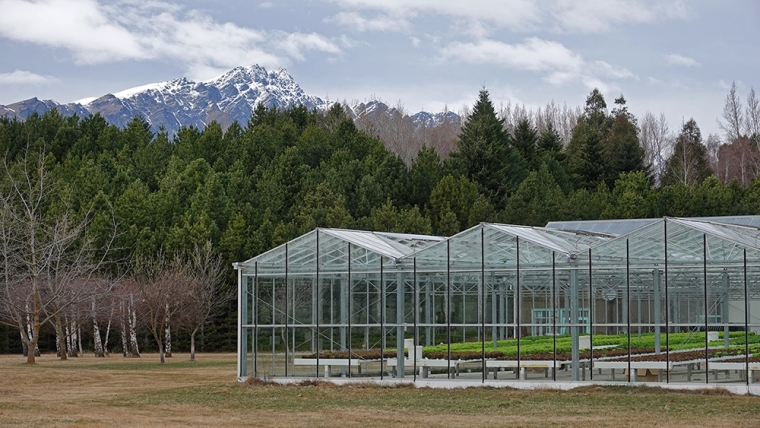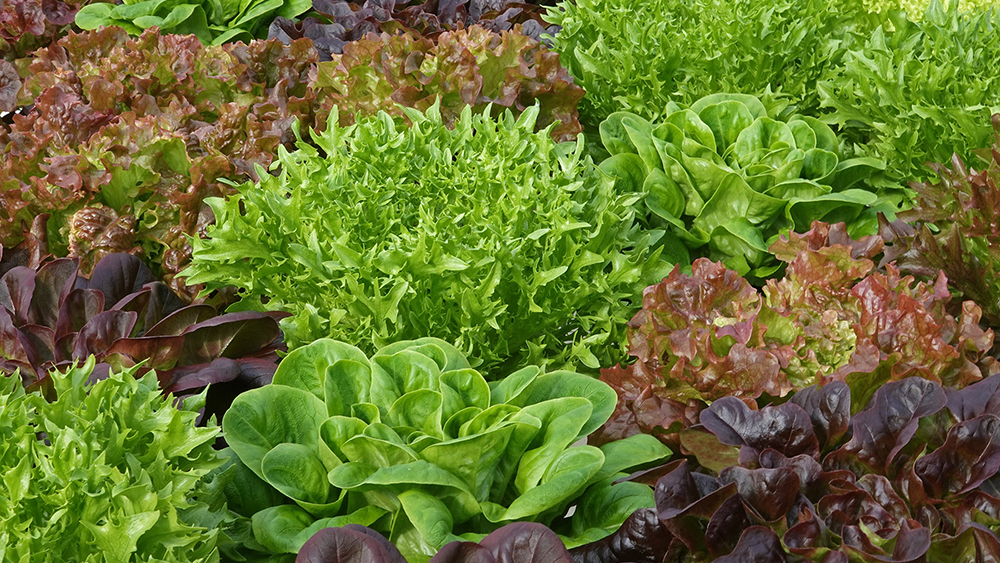
Green vegetables are best produced close to where people live. But nature often needs a little help to make it happen. That is where glasshouses and hydroponics come into play. It is a combination that allows green vegetables to be grown throughout the year in most parts of New Zealand while still being aligned to nature.
Some of my readers will know that I am a fan for the mountains of the Otago Lakes District. Also, for more than 50 years I have been a skier, becoming even more enthusiastic as the years go by, with skiing now providing both joy and adrenaline for a retired mountaineer.
Each year I spend time in the Wakatipu Basin skiing across and down the slopes from daybreak. But not every day is a skiing day, and one recent such morning I spent time with Erika Colby, one half of the Erika and Andrew Colby team at Crystal Gardens.
Erika and Andrew grow premium lettuces for Queenstown and across to Wanaka using their own hydroponic recipes. They have been building up their experience and expertise for close on 30 years. When they started, hydroponics was still in its infancy.
The essence of hydroponics is that plants get the moisture and essential minerals from gently flowing water. There is no need for soil. Plants start their life in a support bed of tiny water-absorbent rock particles such as vermiculite and quickly burrow to the water below with its carefully mixed supply of nutrients.

Lettuce varieties at Crystal Gardens. Photo: Annette Woodford
Hydroponics is a system that works well for quick-growing green leafy vegetables, but it is not the way to grow crops high in energy density such as potatoes, carrots or onions.
One of the reasons hydroponics works so well for green leafy vegetables is that the leaves have a low energy density. The plants have no high-energy-storage organs at this stage of their lives, and so they can be grown at high density, and within a hydroponics system are easily transplanted as they grow. Give them a mix of water and essential minerals, plus sunshine and moderate warmth, then keep them away from pests, and they will look after themselves.
Of course, in practice it is never quite that easy. Glasshouses are fundamental to maintaining the correct range of temperature and humidity. The Wakatipu basin is renowned for its high sunshine hours which is a big help.
One of the challenges of this season has been estimating demand for green vegetables. It was easy to figure out that there would be no overseas tourists, but Queenstown and Wanaka are very much alive with locals. The school holidays were crazy up at the ski-fields. Also, Queenstown is still very much a construction town with many hundreds of trades people working flat out. As one local said to me, there are hundreds of builders, building houses for builders to live in. There are also more hotels and shopping centre still being built. But can it go on?
Riding the chairlifts early in the morning on First Tracks provides great opportunities to talk to the locals. This is the time that the locals are up there, together with the serious racers, while most of the short-term tourists are still rubbing the sleep from their eyes.
First Tracks is not a time for beginners. The snow can be very firm and people are skiing fast. It costs extra to be out at this time, but as an add-on to a season-pass, it is a great investment for the enthusiasts. In contrast, tourists can easily spend more than a season’s First Tracks add-on in a single day with meals, accommodation, transport and lifts.
One of my fellow travellers on the chair this year was a builder from the Waikato who, 18 months ago, bought a Queenstown service station. He reckons that business is down, but he is surviving, and it’s great to be able to pop up the hill for those early morning runs. He plans to stay.
Sometimes I ride with a hotel room-attendant who zooms up and down the slopes each day at a great speed before heading off to work mid-afternoon. Another of my chair-mates was a former financial analyst from Sydney who bought a Lake Hayes property at the time of the GFC back in 2009. He reckons that the Wakatipu Basin is his home for life, and where his bones will be buried.
Last year I chaired with a Queensland surf-shop owner who commutes each winter to the Wakatipu Basin. This year with COVID he is missing. But there is a Japanese couple who come here every year, including this year, having done their quarantine back in June.
There are diverse accents to be heard, including a man from Seattle who now dabbles as a ski instructor on the days he is not child-minding while his American wife works as a speech therapist. There are also Brazilians and Argentinians. There are also folk from England, including a yachtie couple who made it in before COVID and are now hunkering down.
Ski-field regulars are a polyglot type. They are different from the short-term visitors. To a large extent they are people who have decided there has to be more to life than going to the office each day. Some are rich and others live from hand to mouth. These early morning regulars have only one thing in common and it is the joy they get from carving down the slopes before the crowds arrive.
Returning to those lettuces, the genuine outdoor types also tend to be keen on nutrition. So, it all helps in creating a good market for a wide range of lettuce varieties.
Urban folk often think that the future of New Zealand agriculture can be based on vegetables. But it does not work that way because export opportunities are very limited. Also, green vegetables, although important for health, are about 95 percent water. They don’t travel well.
However, growing green vegetables close to consumers is a great way to undertake local production in areas where productive land is limited. The great thing about hydroponics when applied to green vegetables is that it is a technically efficient production system, based on controlled application of water and the necessary nutrients, together with sunlight and a controlled environment. It is a great example of where science, the environment and hard work can come together.
As for my own Wakatipu Basin adventures, they have come to a temporary end. On my most recent day upon the mountain, something went astray and I awoke to find myself together with a now battered helmet in the Coronet Medical Centre, being prepped for a visit to the hospital. While skiing steep and somewhat fast, it seems I may have hit what skiers refer to as a lump of ‘elephant snot’, or alternatively I may have hit a frozen lump known as a ‘death cookie’ sitting frozen in amongst the glistening snow. It can happen. But all is well that ends well, and I will be back next season.
*Keith Woodford was Professor of Farm Management and Agribusiness at Lincoln University for 15 years through to 2015. He is now Principal Consultant at AgriFood Systems Ltd. His articles are archived at http://keithwoodford.wordpress.com. You can contact him directly here.
7 Comments
Nice article Keith. But do you really have pay extra to being on the mountain early (First Tracks)? For 10 years, my Wakatipu was the Hakuba Valley in the southern part of the Japan Alps. Also, the local community was a resourceful bunch whose farming roots go back centuries and they live a calmer, balanced existence. Many Japanese have moved from the cities to places like Nagano Prefecture to improve their lives out of the rat race. Being Japan and post-bubble, they cannot complain about the infrastructure put in place (train network, roads, hospitals) even in rural areas. The whole concept of 'dropping out' is misunderstood as there are many ways to keep productive and relevant to society.
JC,
Yes, I know Hakuba, or at least parts thereof - Happo One, Hakuba 47 and Goryo. It was my first overseas skiing more than ten years ago, except for Antarctica in a previous life and some snow shoing (not very successful) in the Himalayas also in a previous life. NZSki offers a First Track season pass add-on for $250 which gives an hour of peaceful skiing on the fresh but often firm cord (that some call ice) at Coronet from 8am to 9am. In that time, seven runs are possible using the Coronet Express. Then as the crowds start arriving, it is time to drift across to Greengates and the fresh cord over there. For us senior citizens the combined season's package is
The First Tracks pass sounds great and the sason's pass is reasonably priced. Happo and Goryu / 47 are both superb resorts and my cabin was walking distance from the Goryu lift. In fact, Goryu has the steepest run in all of Japan. You probably went down it without realising. I would usually head towards Cortina or Tsugaike.
More than a few NZers and Aussies have played a part in revitalizing the alpine industry in Hakuba and most have committed their lives to being there and are respected by / respectful of the local community. Hakuba is also very popular in the spring and summer seasons for hiking, mountain biking. etc. Because the local population is quite senior now, everyone chips in to support removing snow from rooftops in winter (people get injured and sometimes fatally) and repairing thatched rooves outside winter season.
This is one of those cases where the scoping is not wide enough.
We are omnivores - the reason some folk go vegetarian or vegan, is because of their planetary footprint. This is an overpopualtion issue, and goes hand in hand with the unasked (by the writer) reason for exporting food (it's because others are too numerous for their acreage).
Meat is a secondary energy uptake; more concentrated when eaten, worse use of solar energy in the whole deal, due to the energy loss in the animal (low grade heat being the usual culprit). Eating the solar energy as soon in the system as possible, loses the least energy.
Hydroponics need constant attention and most importantly; supplied nutrients. Organic/regenerative growing knocks it into a cocked hat - but glasshouses are legit, the cooler/further south you do your growing.
Apples with apples is the best way to have the discussion. Exporting is unsustainable, and is increasingly being paid with irreconcilable debt; why do it? Answer; because whole lots of people though they could 'make money' from doing so. Caveat: you don't 'make money', wealth is having access to resources and energy - which is what are being exported flat-out.
Yes, we need to feed cities as much as possible, from as close as possible. Yes, we can keep growing meat on the lower-class soils. No, not at present overstocking-rates. But that's OK, beyond fossil energy there's going to be huge demand for firewood - this is where we have to be thinking systemically; one discipline pushing its POV will always be wrong from here on in.
And here's something to read right through, Keith: https://royalsoc.org.au/images/pdf/journal/152-1-Turner.pdf





We welcome your comments below. If you are not already registered, please register to comment.
Remember we welcome robust, respectful and insightful debate. We don't welcome abusive or defamatory comments and will de-register those repeatedly making such comments. Our current comment policy is here.